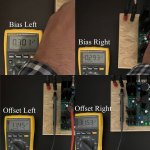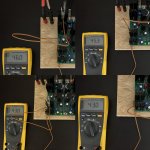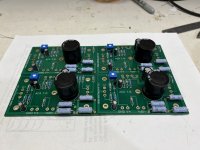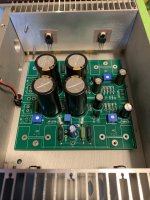Negative 2nd harmonic rules!
And then the MUCH bigger A2s powered their way with the Maggie 1.7s.... Traffic, On The Road, The Low Spark Of The High Heeled Boys...
and reminded me once again that as good as the First Watt is... sometimes, it takes the First Hundred Watts.
My desert island will require a big sound room to hold all of those amps and speakers. ;-)
The difference is between the head and the body. The smaller amps do fill the head, but... OK... maybe it's my choice of speakers.... I use different speakers for low and high powered amps. The Maggie 1.7s and A2s are a marriage made in heaven. God Knows what I will need if I up the ante to the 3.8s.
Deeper bass, the soundstage is a bit less accurate, but that's the Maggies I think, but the tapestry of the music, that mixture of instruments and voices comes through clearly. It's just that the larger set up allows a bit more headroom... more... more sound. The instruments don't move in space, they just get louder.
The low powered setup is definitely a cool cat... then the high powered set up enters and takes you on a 25 minute day dream lost in the music.
You know... those A2s are damn good! And so are the Minis.... and F4...and, and, and...
I think the Mini, with jumpers in place, is like an Aleph with a lower noise floor and perhaps more accuracy, but limited dynamics and bass.
The F4, btw, is an entirely different proposition...
But, oh, it's FUN.
PS: I wonder what a pair of XA200.8 amps would sound in my house.... Ay! Nelson is an evil guy.... there is method in his genius... gulp:
Power Consumption @ Idle (Watts) 760
Unit Dimension (W x D x H)(In.) 19 x 27.5 x 11
Unit Weight (LBS) 157
Last edited:
I loved my little MMGs before my dog delaminated the HF panel by scratching it because he thought Joni Mitchell was at the door! I always did dream about getting more realistic bass though.
Have you thought about finding a way to biamp your 1.7s?
Have you thought about finding a way to biamp your 1.7s?
After one week of using the fairchild version, I don't share the opinion that this is the better amp than the Harris ACAmini!
I think, the Fairchild version is showing higher levels of harmonic distortions than the Harris version. Maybe due to the fact that the P-version of the fairchilds are 200 Volt types and the N-version 300V. Could be they have completely different output characteristics?
BTW: I just used the « jumper in» settings and did not compare the sound without the jumpers. And yes, the best example to recognize the «true» sound was the Köln Concert from Keith Jarrett. Grand Piano is very good to judge if there is a piano playing or if you hear a big amount of sound effects.
BTW: I am aware that all ACAmini’s are some kind sound effect machines, but in a perfect way! These are not clean amps with 0,00000x% THD and that makes the fascinating character of this little gems!
P.S.
I used a Pass 6X24 crossover and the ACA mini has driven open baffles with chinese Diatone P610 alnico clones, supported by a subwoofer driven by a t-amp.
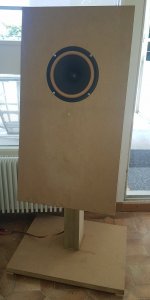
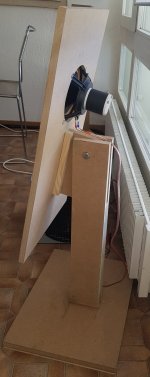
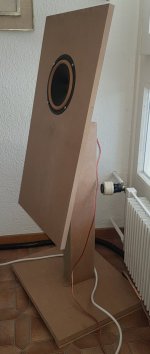
I think, the Fairchild version is showing higher levels of harmonic distortions than the Harris version. Maybe due to the fact that the P-version of the fairchilds are 200 Volt types and the N-version 300V. Could be they have completely different output characteristics?
BTW: I just used the « jumper in» settings and did not compare the sound without the jumpers. And yes, the best example to recognize the «true» sound was the Köln Concert from Keith Jarrett. Grand Piano is very good to judge if there is a piano playing or if you hear a big amount of sound effects.
BTW: I am aware that all ACAmini’s are some kind sound effect machines, but in a perfect way! These are not clean amps with 0,00000x% THD and that makes the fascinating character of this little gems!
P.S.
I used a Pass 6X24 crossover and the ACA mini has driven open baffles with chinese Diatone P610 alnico clones, supported by a subwoofer driven by a t-amp.



NOT better…just different. It’s a matter of preference.After one week of using the fairchild version, I don't share the opinion that this is the better amp than the Harris ACAmini!
NOT better…just different. It’s a matter of preference. You’ve proven the point that they do sound different.
If you have a preference for jumper position then there is a clue to the difference between the output devices.
I loved my little MMGs before my dog delaminated the HF panel by scratching it because he thought Joni Mitchell was at the door! I always did dream about getting more realistic bass though.
Have you thought about finding a way to biamp your 1.7s?
No. I find the A2 has more than sufficient power and bass in the 1.7s. Going from the A5 monos to the A2s it felt like an additional lower octave opened up.
After one week of using the fairchild version, I don't share the opinion that this is the better amp than the Harris ACAmini!
I think, the Fairchild version is showing higher levels of harmonic distortions than the Harris version. Maybe due to the fact that the P-version of the fairchilds are 200 Volt types and the N-version 300V. Could be they have completely different output characteristics?
BTW: I just used the « jumper in» settings and did not compare the sound without the jumpers. And yes, the best example to recognize the «true» sound was the Köln Concert from Keith Jarrett. Grand Piano is very good to judge if there is a piano playing or if you hear a big amount of sound effects.
My Mini has the Harris. I prefer (*) how they sound with the jumpers in place. I have not heard the Fairchild... the builder of my amp has listened to both, his stated preference is the opposite of mine when using the Fairchild.
But then, I have spent the better part of the last six years with some kind of Aleph amp as my "main amp"...
I find that with the jumpers in place the sound has more "pace": it sounds more realistic and full. Without the jumpers in place the sound was threadbare, I'd call it No Fat Milk sound and, to me, is boring and uninteresting. The speakers I'm running it with are Elac Unifi 2.0 UB52 which are only 85 db/w.
(*) I know it's not the most accurate, as the F4 sounds extremely good too and... different. But, but...
Last edited:
Hello again all.
Thank you for the help. For completeness' sake, let me share my experience with this amazing little piece of electronics. This may perhaps be of some help to future builders!
First thing to remember, the transistors are all different! I had made the rookie mistake off switching MOSFETs in the right channel. Good news is the SMPS brick immediately goes into protection mode, and no damage is done.
I had set the biases and offsets on my bench using a single voltmeter (took my time) approximately at first. Then I had my dinner and refined the settings about an hour later. Voltages values had remained quite stable anyway.
Then I brought it upstairs to its workplace. Took a litle while to get everything ready, so the amp had cooled to ambient temperature.
The source (FM radio in MONO mode) was ON before firing up the amplifier. After turning switch ON: music only in right channel at first!
Balance L-R was achieved after about 10 minutes (relief!!!): the left channel took significantly longer than the right channel to come to life at first. Note that the misplaced transistors were in the right channel, so this has nothing to do with it. Also, all four MOSFETs are mounted using about the same VERY small amount of white thermal paste, smeared properly. Bolts were torqued approximately the same (close enough...). For a long time, the left channel IRF520 was noticeably cooler than the other three.
Following the suggestion from KevinHeem, I cycled it off and on a few times since. As far as I can see, that's all that was needed. Now biases and voltages are very stable and sound is of course still amazing. I was able to measure the heatsink temperatures after I located my thermocouple, with no signal--don't want electrons to be diverted to those pesky speaker voice coils! Amp had been on for more than 24 hrs. The temperature values themselves need to be taken with a grain of silicon, but they were all measured the same way. As can be seen in images below, they are close enough to each other now, including the strange lower left one! My living room was about 20 degrees.
So everything is great and thank you again and again for an amazing design, Mr. Pass!!! Cheers all.
--Christian
P.S. Now I need to finish those two ACAs, destined to monoblock operation!
Thank you for the help. For completeness' sake, let me share my experience with this amazing little piece of electronics. This may perhaps be of some help to future builders!
First thing to remember, the transistors are all different! I had made the rookie mistake off switching MOSFETs in the right channel. Good news is the SMPS brick immediately goes into protection mode, and no damage is done.
I had set the biases and offsets on my bench using a single voltmeter (took my time) approximately at first. Then I had my dinner and refined the settings about an hour later. Voltages values had remained quite stable anyway.
Then I brought it upstairs to its workplace. Took a litle while to get everything ready, so the amp had cooled to ambient temperature.
The source (FM radio in MONO mode) was ON before firing up the amplifier. After turning switch ON: music only in right channel at first!
Balance L-R was achieved after about 10 minutes (relief!!!): the left channel took significantly longer than the right channel to come to life at first. Note that the misplaced transistors were in the right channel, so this has nothing to do with it. Also, all four MOSFETs are mounted using about the same VERY small amount of white thermal paste, smeared properly. Bolts were torqued approximately the same (close enough...). For a long time, the left channel IRF520 was noticeably cooler than the other three.
Following the suggestion from KevinHeem, I cycled it off and on a few times since. As far as I can see, that's all that was needed. Now biases and voltages are very stable and sound is of course still amazing. I was able to measure the heatsink temperatures after I located my thermocouple, with no signal--don't want electrons to be diverted to those pesky speaker voice coils! Amp had been on for more than 24 hrs. The temperature values themselves need to be taken with a grain of silicon, but they were all measured the same way. As can be seen in images below, they are close enough to each other now, including the strange lower left one! My living room was about 20 degrees.
So everything is great and thank you again and again for an amazing design, Mr. Pass!!! Cheers all.
--Christian
P.S. Now I need to finish those two ACAs, destined to monoblock operation!
Attachments
well do you like ?Hello again all.
Thank you for the help. For completeness' sake, let me share my experience with this amazing little piece of electronics. This may perhaps be of some help to future builders!
First thing to remember, the transistors are all different! I had made the rookie mistake off switching MOSFETs in the right channel. Good news is the SMPS brick immediately goes into protection mode, and no damage is done.
I had set the biases and offsets on my bench using a single voltmeter (took my time) approximately at first. Then I had my dinner and refined the settings about an hour later. Voltages values had remained quite stable anyway.
Then I brought it upstairs to its workplace. Took a litle while to get everything ready, so the amp had cooled to ambient temperature.
The source (FM radio in MONO mode) was ON before firing up the amplifier. After turning switch ON: music only in right channel at first!
Balance L-R was achieved after about 10 minutes (relief!!!): the left channel took significantly longer than the right channel to come to life at first. Note that the misplaced transistors were in the right channel, so this has nothing to do with it. Also, all four MOSFETs are mounted using about the same VERY small amount of white thermal paste, smeared properly. Bolts were torqued approximately the same (close enough...). For a long time, the left channel IRF520 was noticeably cooler than the other three.
Following the suggestion from KevinHeem, I cycled it off and on a few times since. As far as I can see, that's all that was needed. Now biases and voltages are very stable and sound is of course still amazing. I was able to measure the heatsink temperatures after I located my thermocouple, with no signal--don't want electrons to be diverted to those pesky speaker voice coils! Amp had been on for more than 24 hrs. The temperature values themselves need to be taken with a grain of silicon, but they were all measured the same way. As can be seen in images below, they are close enough to each other now, including the strange lower left one! My living room was about 20 degrees.
So everything is great and thank you again and again for an amazing design, Mr. Pass!!! Cheers all.
--Christian
P.S. Now I need to finish those two ACAs, destined to monoblock operation!
Hi Everyone, Santa is packing up lots of ACAmini Essentials (pcb + fets) for the Store, and
I want to inform customers that the Bill of Materials has been altered, changing the value of
the bias trim pots to 2 Kohm, up from 1 Kohm to accommodate the ranges we are getting
from the Mosfet/Jfet pairs. Previously we could work with up to 1K, but now the upper limit
is a little higher, and 2K is the next value pot on the scale of availability..
There is no performance hit. Completion kits from the store will reflect this change, and will
work fine with boards purchased previously.

I want to inform customers that the Bill of Materials has been altered, changing the value of
the bias trim pots to 2 Kohm, up from 1 Kohm to accommodate the ranges we are getting
from the Mosfet/Jfet pairs. Previously we could work with up to 1K, but now the upper limit
is a little higher, and 2K is the next value pot on the scale of availability..
There is no performance hit. Completion kits from the store will reflect this change, and will
work fine with boards purchased previously.

Papa,
This has certainly been one heck of a gift! I’ve been listening to mine as much as I can and I absolutely love it!
Merry Christmas 🌲🌲🌲
This has certainly been one heck of a gift! I’ve been listening to mine as much as I can and I absolutely love it!
Merry Christmas 🌲🌲🌲
Nelson,Hi Everyone, Santa is packing up lots of ACAmini Essentials (pcb + fets) for the Store, and
I want to inform customers that the Bill of Materials has been altered, changing the value of
the bias trim pots to 2 Kohm, up from 1 Kohm to accommodate the ranges we are getting
from the Mosfet/Jfet pairs. Previously we could work with up to 1K, but now the upper limit
is a little higher, and 2K is the next value pot on the scale of availability..
There is no performance hit. Completion kits from the store will reflect this change, and will
work fine with boards purchased previously.

Should I replace the 1K pots with the 2K? I just finished assembling the old kit
IRFP devices? Before doing that just see if you can achieve proper bias,Nelson,
Should I replace the 1K pots with the 2K? I just finished assembling the old kit.
nope only for the new ones from storeNelson,
Should I replace the 1K pots with the 2K? I just finished assembling the old kit
Question, how much bias can these little 520/9520's and the circuit handle? I have mine at .400v right now. They are mounted to rather large heatsinks and the MOSFETs are just barely warm. It seems as though I can crank it up quite a bit and still be good.
- Home
- Amplifiers
- Pass Labs
- DIY ACA mini
